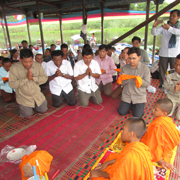
|
As the 4-year IUCN/FACT EU-funded project “Strengthening Capacity of Fishing Communities in the Tonle Sap to Manage their Natural Resources Sustainably” enters its final stages, the results in Phlov Touk, one of three pilot sites where we have helped establish fish conservation areas (FCAs) under the management of Community Fisheries (CFi) committees, are becoming clear.
|
|
| In 2013, the project established a 24.4-hectare FCA that includes three deep pools (where fish congregate during the dry season) and a Ghost Forest that the local people wanted to protect for cultural and potential tourism values (Phlov Touk is just three hours from Phnom Penh by car and boat). The FACT field coordinator has carried out quarterly focus group discussions with the CFi committee and has trained committee members to collect data on fish catch and prices every month. |  |
| The most important results have been the reduction in illegal fishing inside the FCA and increased fish catch in and around the FCA during the high fishing season from January to April. In 2015, an experienced fisher estimated that there were about 30 tons of fish in one of the deep pools, including large and valuable Trey Kesh (Kryptopterus micronema). Increased fish catch, our monitoring suggests, has contributed to reduced debt and hunger. There has also been no more clearing of the Ghost Forest. |
| These successes are largely due to patrolling of the FCA organized by the CFi committee. At first, only 4-5 committee members were willing to join the patrols, but since 2014 more members and their families have participated. The committee pays for half of the patrolling costs (mostly fuel), which indicates its strong commitment to FCA protection. The project has improved protection by installing tree trunks that provide natural habitat for fish to develop and deter fish nets. |  |
| At the start of the project, 5-10 of the 435 families in Phlov Touk continued to fish in the FCA at night when there was no patrolling. As a result, by one estimate, 50% of the fish were lost from the FCA in 2014. The CFi committee responded by posting a floating guard post close to the FCA to provide 24/7 surveillance. Some outsiders still try and fish in the FCA with six of the 13 cases of illegal fishing from January to April 2015 being committed by outsiders. Efforts to prevent outsiders entering the FCA have been hampered by disagreement with the Fisheries Administration over whether or not the patrol teams have the power to arrest and fine illegal fishers. Hopefully, this will be clarified in the revised CFi sub-decree. |  |
|
At a ceremony in July 2015, monks dropped a stone wrapped in an orange loin-cloth to the bottom of the FCA in order to deter illegal fishing on the basis that stealing from a spirit’s property has repercussions in the afterlife. Similarly, orange cloths have been tied on trees around the Ghost Forest. Additional deterrence will, we hope, be provided by a new signboard posted in the FCA that makes clear that fishing inside the FCA is illegal. IUCN and FACT are helping the CFi committee prepare a management plan for the FCA that addresses long-term financing for the patrols. The committee plans to establish a savings group, whereby interest earned can help pay for the patrols. Every two months, committee members attend meetings of the commune council to lobby for financing from the commune investment fund. There is also the possibility of developing the area’s ecotourism potential. No single measure would be sufficient but together they could finance protection of the FCA long after the project ends and ensure that the community continues to benefit from larger and more secure fish harvests. By Daniel Chadder (Internship Student from University of East Anglia (UEA), England and Vong Keosothun (Field Coordinator from FACT) |















Leave a Reply